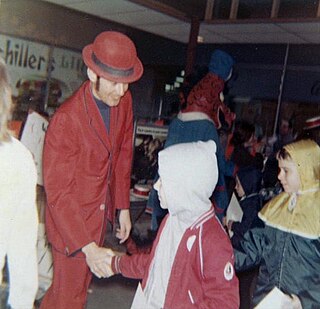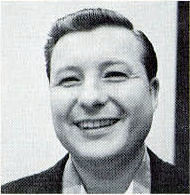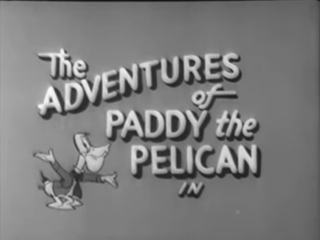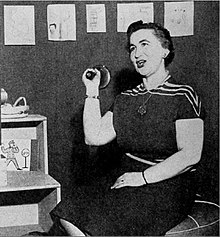
Garfield Goose and Friends is a children's television show produced by WGN-TV in Chicago, Illinois, United States, from 1955 to 1976. The show was known as Garfield Goose and Friend from 1952 to 1955 when it aired on WBKB and WBBM-TV. It was the longest running puppet show on television until Sesame Street broke that record. The host of the show was Frazier Thomas, who did all of the talking. The show centered on a clacking goose puppet named Garfield Goose, who considered himself "King of the United States." There were many other puppet characters such as Romberg Rabbit, Macintosh Mouse, Chris Goose and a sleepy bloodhound called Beauregard Burnside III. The show used a "Little Theater Screen", upon which the camera would zoom before cartoons such as Total Television, The Funny Company, Clutch Cargo, The Pink Panther, Jay Ward, Hanna-Barbera, Space Angel and The Mighty Hercules were broadcast.
KFYR-TV is a television station in Bismarck, North Dakota, United States, affiliated with NBC and Fox. Owned by Gray Television, the station has studios on North 4th Street and East Broadway Avenue in downtown Bismarck, and its transmitter is located near St. Anthony, North Dakota.

WMAQ-TV is a television station in Chicago, Illinois, United States, serving as the market's NBC outlet. It is owned and operated by the network's NBC Owned Television Stations division alongside Telemundo station WSNS-TV. The two stations share studios at the NBC Tower on North Columbus Drive in the city's Streeterville neighborhood and broadcast from the same transmitter atop the Willis Tower in the Chicago Loop.

Ray Rayner was an American television presenter, actor and author. He was a staple of Chicago children's television in the 1960s and 1970s on WGN-TV.

William Frazier Thomas was a Chicago television personality. Although Thomas wrote nine children's books, he was best known for creating, hosting, writing and producing the long-running children's television program Garfield Goose and Friends on WGN-TV.

Bill Ray Jackson was an American television personality, cartoonist, and educator. He was best known for having hosted the children's programs The BJ and Dirty Dragon Show and Gigglesnort Hotel.

Gigglesnort Hotel is a syndicated children's television program which ran for 78 episodes between 1975 and 1978. It was hosted by Bill Jackson, previously the host of several Chicago-based children's programs including Clown Alley and The BJ and Dirty Dragon Show. The program was set, as the title implies, at an old hotel, where Jackson's role was a desk clerk. The program featured many of the characters from the previous show, including Dirty Dragon, the Old Professor, Weird, Old Mother Plumtree, and several others who were created just for the program, such as the hotel's owner, Old Man Gigglesnort.

Frances Rappaport Horwich was an American educator, television personality and television executive. As Miss Frances, she was the host of the children's television program Ding Dong School, seen weekday mornings on the NBC network in the 1950s and nationally syndicated between 1959 and 1965.

Roy Thomas Brown was an American television personality, puppeteer, clown and artist known for playing "Cooky the Cook" on Chicago's Bozo's Circus.

The BJ and Dirty Dragon Show is a Chicago children's television program that aired on WFLD and later WGN-TV from 1968 to 1974. It starred Bill Jackson and his puppets.

Norbert Locke, better known as Ned Locke, was an American television personality and radio announcer, best known for the role of "Ringmaster Ned" on WGN-TV's Bozo's Circus from 1961 - 1976.

Cuddly Dudley is a lifesize shiny plush stuffed animal nostalgic cocker spaniel doll that was used as a subscription sales promotional item by the Chicago Tribune in the mid-1960s. In addition, the animal took on a life of its own as a recurring puppet character on Chicago children's TV for many years.

Super Circus is an American television program that aired live on Sunday afternoons from 5 to 6pm Eastern Time from 1949 to 1956 on ABC. The show was produced in Chicago by WENR-TV, continuing through its call letter change to WBKB through 1955, and its production moved to New York City and WABC-TV for its final season. The award-winning show featured circus and clown acts performing in front of a studio audience. Mary Hartline and Claude Kirchner were the hosts, and Bruce Chase conducted the band. Phil Patton was the producer, and Ed Skotch was the director. Sponsors for the show included Kellogg's, Mars, Canada Dry Ginger Ale, and Sweetheart Soap.

The Adventures of Paddy the Pelican is an American animated television series that debuted on local stations in Chicago during the 1950s. It is exceedingly rare, but has gained some fame for appearing on Jerry Beck's Worst Cartoons Ever. On the DVD, Beck states that he has not found any evidence that this particular animated adaptation was aired on TV, although there is evidence that the Paddy the Pelican character began in 1950 as a local TV puppet show on Chicago's WENR-TV, with Helen York and Ray Suber as puppeteers.

Zoo Parade is an American television program broadcast from 1950 to 1957 that featured animals from the Lincoln Park Zoo in Chicago. Presented by Marlin Perkins, the show was broadcast on Sunday afternoons on NBC.

Lorraine Meinecke , known professionally as Angel Casey, was an American television and radio actress.

Judith Cary Waller was an American broadcasting pioneer. Despite the fact that she knew nothing about radio at the time, she became the first station manager of Chicago radio station WMAQ when it went on the air in 1922. She was one of the first female radio station managers in the United States, along with Eleanor Poehler of WLAG/WCCO in Minneapolis, and Bertha Brainard of WJZ and Vaughn De Leath of WDT in New York City. During her tenure as station manager, Waller was responsible for obtaining broadcast rights for Chicago Cubs home games for WMAQ and for hiring Freeman Gosden and Charles Correll as Amos 'n' Andy after they left WGN radio over syndication rights. Waller tried to interest the CBS radio network in the program with no success. NBC brought the program to its Blue Network three years before its purchase of WMAQ in 1931.
The 1953 Sylvania Television Awards were presented on December 1, 1953, at Hotel Pierre in New York City. The Sylvania Awards were established by Sylvania Electric Products. The awards were selected by a committee of 16 judges led by Deems Taylor.
American Inventory is a thirty-minute weekly filmed educational series that first aired as a summer replacement Sunday nights during 1951 on NBC. It was funded by the Alfred P. Sloan Foundation with NBC donating the broadcast time and facilities. The series incorporated panel discussions, lectures from experts, film of activities and events taking place out of the studio, and occasional in-studio dramatic scenes. It was an ambitious project, the first educational series produced and broadcast by a network.
Elmer the Elephant is an American children's television series broadcast by WNBQ-Ch.5. It aired from 5:00 to 5:30 on weekday afternoons from 1951 to 1956. John Conrad stars in and created Elmer the Elephant. The show was canceled in 1956, but then returned from 1962 to 1964, with the same format. Conrad noted that "if you've got a winning formula, why mess with it?".
















